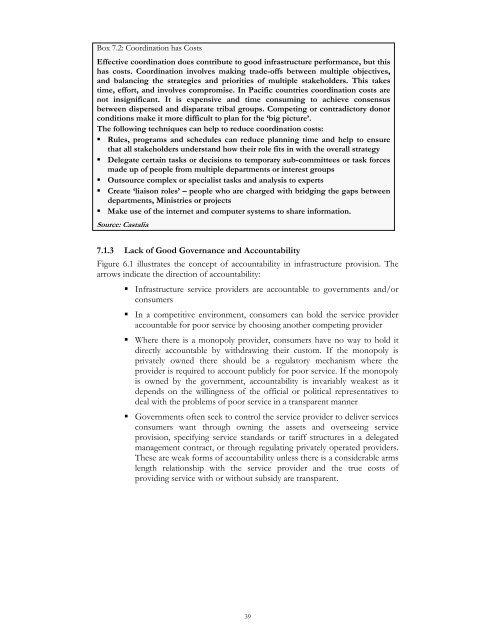EAP - The Pacific Infrastructure Challenge - World Bank (2006).pdf
EAP - The Pacific Infrastructure Challenge - World Bank (2006).pdf
EAP - The Pacific Infrastructure Challenge - World Bank (2006).pdf
You also want an ePaper? Increase the reach of your titles
YUMPU automatically turns print PDFs into web optimized ePapers that Google loves.
Box 7.2: Coordination has Costs<br />
Effective coordination does contribute to good infrastructure performance, but this<br />
has costs. Coordination involves making trade-offs between multiple objectives,<br />
and balancing the strategies and priorities of multiple stakeholders. This takes<br />
time, effort, and involves compromise. In <strong>Pacific</strong> countries coordination costs are<br />
not insignificant. It is expensive and time consuming to achieve consensus<br />
between dispersed and disparate tribal groups. Competing or contradictory donor<br />
conditions make it more difficult to plan for the ‘big picture’.<br />
<strong>The</strong> following techniques can help to reduce coordination costs:<br />
Rules, programs and schedules can reduce planning time and help to ensure<br />
that all stakeholders understand how their role fits in with the overall strategy<br />
Delegate certain tasks or decisions to temporary sub-committees or task forces<br />
made up of people from multiple departments or interest groups<br />
Outsource complex or specialist tasks and analysis to experts<br />
Create ‘liaison roles’ – people who are charged with bridging the gaps between<br />
departments, Ministries or projects<br />
Make use of the internet and computer systems to share information.<br />
Source: Castalia<br />
7.1.3 Lack of Good Governance and Accountability<br />
Figure 6.1 illustrates the concept of accountability in infrastructure provision. <strong>The</strong><br />
arrows indicate the direction of accountability:<br />
<strong>Infrastructure</strong> service providers are accountable to governments and/or<br />
consumers<br />
In a competitive environment, consumers can hold the service provider<br />
accountable for poor service by choosing another competing provider<br />
Where there is a monopoly provider, consumers have no way to hold it<br />
directly accountable by withdrawing their custom. If the monopoly is<br />
privately owned there should be a regulatory mechanism where the<br />
provider is required to account publicly for poor service. If the monopoly<br />
is owned by the government, accountability is invariably weakest as it<br />
depends on the willingness of the official or political representatives to<br />
deal with the problems of poor service in a transparent manner<br />
Governments often seek to control the service provider to deliver services<br />
consumers want through owning the assets and overseeing service<br />
provision, specifying service standards or tariff structures in a delegated<br />
management contract, or through regulating privately operated providers.<br />
<strong>The</strong>se are weak forms of accountability unless there is a considerable arms<br />
length relationship with the service provider and the true costs of<br />
providing service with or without subsidy are transparent.<br />
39

















